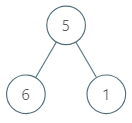Problem: Given a Linked List of size N, where every node represents a sub-linked-list and contains two pointers:
- a next pointer to the next node,
- a bottom pointer to a linked list where this node is head.
Each of the sub-linked-list is in sorted order.
Flatten the Link List such that all the nodes appear in a single level while maintaining the sorted order.
Note: The flattened list will be printed using the bottom pointer instead of the next pointer.
Example:
Input:
5 -> 10 -> 19 -> 28
| | | |
7 20 22 35
| | |
8 50 40
| |
30 45
Output: 5-> 7-> 8- > 10 -> 19-> 20->
22-> 28-> 30-> 35-> 40-> 45-> 50.
Explanation:
The resultant linked lists has every
node in a single level.
(Note: | represents the bottom pointer.)Input:
5 -> 10 -> 19 -> 28
| |
7 22
| |
8 50
|
30
Output: 5->7->8->10->19->22->28->30->50
Explanation:
The resultant linked lists has every
node in a single level.
(Note: | represents the bottom pointer.)Approach: We can treat every node as separate list where next pointer is bottom pointer. Now this will just become the problem of merging sorted lists.
That's all!
Implementation in Java:
Node flatten(Node root)
{
if (root == null || root.next == null)
{
return root;
}
root.next = flatten(root.next);
return merge(root, root.next);
}
private Node merge(Node node1, Node node2)
{
if (node1 == null)
{
return node2;
}
if (node2 == null)
{
return node1;
}
Node result = null;
if (node1.data <= node2.data)
{
result = node1;
result.bottom = merge(node1.bottom, node2);
}
else
{
result = node2;
result.bottom = merge(node1, node2.bottom);
}
result.next = null;
return result;
}
Complexity: O(n) where n is total number of nodes in the list including the bottom nodes.


